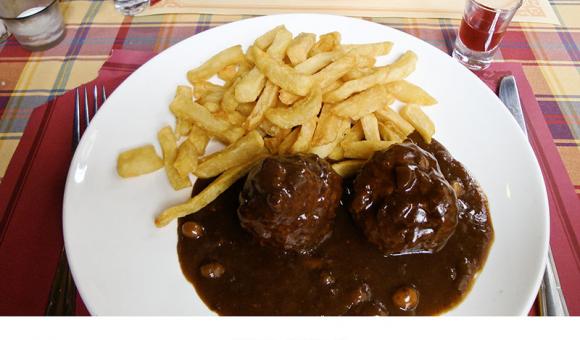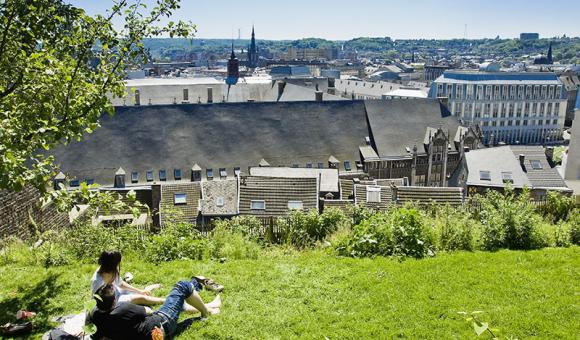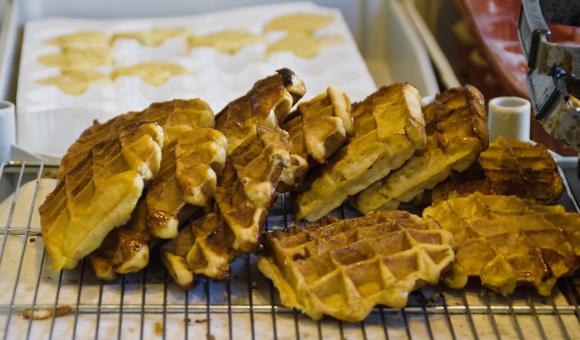Liège is undoubtedly Wallonia's warmest city. As for the people of Liège, they are friendly, welcoming and they love to celebrate all through the night. In addition to the typical neighbourhoods of Outremeuse, Pierreuse or the coteaux de la Citadelle, there are also the banks of the Meuse, with the newly converted quays which benefit pedestrians and in summer see their lawns covered in sunbathers along the riverbank.
Going out
The most festive part of Liège, where the fun hasn’t stopped for generations, is the "Carré". The "Carré" never sleeps and is entirely dedicated to parties that go on until dawn and student celebrations. Another highlight of Liège's party calendar: Liège Fair in October. For a whole month (and a bit longer), the rides, chip vans and candy floss stalls, slides and thrill rides take over the boulevards from rue des Guillemins to the city centre on rue Pont d’Avroy. The 15 August sees all the people of Liège descend upon the Free Republic of Outremeuse along with a large number of tourists. For three days, Outremeuse is the centre of the world and the capital city of pékèt. Tchantchès and his partner Nanesse are the king and queen of proceedings. The 15 August remains, however, a religious festival and the procession honours ‘La Vièrge Noire’ (the black virgin). During the Christmas holidays, come and visit the Christmas market and its chalets spread all over the city. If you’re feeling the bite of the cold weather, why not have a mulled wine or a ‘bouquettes’, a local treat.
Liège, the cultural city
Liège has many other riches. It has many museums covering various themes: the Grand Curtius tells the story of Walloon life throughout the centuries. Liège Aquarium and the Maison de la Science, are places of discovery and study frequented by young pupils, university students and families alike. Musée Grétry is housed in the house in which the composer was born and contains some of his personal objects and documents.
Tchantchès, the puppet mascot whose rebellious spirit and cheekiness is emblematic of the city, also has his own museum. Unlike any other, the Mad’Musée is dedicated to a different kind of art and organises exhibitions of works created by mentally handicapped artists.
For lovers of history, the Archéoforum lies just beneath Place Saint-Lambert, with an itinerary that is perfectly suited to families. The Museum of Metallurgy and Industry and the Public Transport museum bear witness to a not-so-distant past. You cannot leave Liège without seeing its two treasures: the one in the cathedral and the baptismal fonts of Saint-Bartholomew. Take the time to wander through the streets of Liège and discover its architectural heritage: the Prince-Bishops’ Palace, the Guillemins train station, designed by architect Santiago Calatrava, the cathedral, ...
There’s also the Opéra Royal, the Georges Simenon itinerary, concerts, the discovery of typical alleyways and squares like en Neuvice or Place du Marché, with the Perron and its cafés.
Liège, the gourmet city
If the people of Liège like to celebrate, they are also lovers of great food. The local recipes show the generosity of the inhabitants throughout the centuries. If you visit Liège, you must try boulets sauce lapin or sauce chasseur. You also need to sample bouquettes (thick pancakes made with buckwheat flour and currants), Sirop de Liège and Herve cheese, the liège Salad, pékèt, Liège waffles… Many restaurants have made this local cuisine their speciality, such as “La Maison du Pekèt” behind the city hall, “chez Lequet” for those who wander through la Batte market on Sundays and “chez Tchantchès”. Liège also hosts two large gastronomic events: “Les Epicuriales”, an open-air restaurant and the “Village Gaulois”.
Liège has many characters
- A student character, with its university in the city centre and up on the Sart-Tilman. Many students have “digs” in town and congregate in the Carré, at the cinema or at one of the city’s music festivals. The University of Liège welcomes students from numerous countries.
- Sporty, with Royal Standard Club de Liège, the city’s football club, nicknamed ”les Rouches”. The team has the world’s most enthusiastic football supporters and owes them more than a few victories. The “Standardmen” can’t afford to lose, their supporters won’t allow it.
- Green, with its walks on the coteaux de la Citadelle, the stairs of the montagne de Bueren, the Avroy, Boverie and Botanical parks, the slagheaps which have been reconquered by nature and even the stunning plains and cultivations high above the city…
- Secretive and discreet, with its alleyways and dead-ends that are invisible to visitors in a hurry.
- Popular, with its markets and flea markets, of which the most famous is, without doubt, la Batte. This weekly Sunday market attracts a huge international crowd.




